Radiation Effects on Pure-Silica Multimode Optical Fibers in the Visible and Near-Infrared Domains: Influence of OH Groups
Abstract
:1. Introduction
2. Materials and Methods
2.1. Tested Optical Fibers
2.2. H2 Loading and Thermal Treatment
2.3. Irradiation Conditions
3. Results
4. Discussion
5. Conclusions
Author Contributions
Funding
Institutional Review Board Statement
Informed Consent Statement
Data Availability Statement
Conflicts of Interest
References
- Girard, S.; Kuhnhenn, J.; Gusarov, A.; Brichard, B.; Van Uffelen, M.; Ouerdane, Y.; Boukenter, A.; Marcandella, C. Radiation Effects on Silica-Based Optical Fibers: Recent Advances and Future Challenges. IEEE Trans. Nucl. Sci. 2013, 60, 2015–2036. [Google Scholar] [CrossRef]
- Girard, S.; Morana, A.; Ladaci, A.; Robin, T.; Mescia, L.; Bonnefois, J.-J.; Boutillier, M.; Mekki, J.; Paveau, A.; Cadier, B.; et al. Recent Advances in Radiation-Hardened Fiber-Based Technologies for Space Applications. J. Opt. 2018, 20, 093001. [Google Scholar] [CrossRef] [Green Version]
- Hartog, A.H. An Introduction to Distributed Optical Fibre Sensors; Series in Fiber Optic Sensors; Published June 2018, CRC Press: Boca Raton, FL, USA; ISBN 978-1-138-08269-4.
- Bao, X.; Chen, L. Recent Progress in Distributed Fiber Optic Sensors. Sensors 2012, 12, 8601–8639. [Google Scholar] [CrossRef] [PubMed] [Green Version]
- Brichard, B.; Fernandez, A.F.; Ooms, H.; Berghmans, F.; Decréton, M.; Tomashuk, A.; Klyamkin, S.; Zabezhailov, M.; Nikolin, I.; Bogatyrjov, V.; et al. Radiation-Hardening Techniques of Dedicated Optical Fibres Used in Plasma Diagnostic Systems in ITER. J. Nucl. Mater. 2004, 329-333, 1456–1460. [Google Scholar] [CrossRef]
- Brichard, B.; Tomashuk, A.L.; Bogatyrjov, V.A.; Fernandez, A.F.; Klyamkin, S.N.; Girard, S.; Berghmans, F. Reduction of the Radiation-Induced Absorption in Hydrogenated Pure Silica Core Fibres Irradiated in Situ with γ-Rays. J. Non-Cryst. Solids 2007, 353, 466–472. [Google Scholar] [CrossRef]
- Brichard, B.; Tomashuk, A.L.; Ooms, H.; Bogatyrjov, V.A.; Klyamkin, S.N.; Fernandez, A.F.; Berghmans, F.; Decréton, M. Radiation Assessment of Hydrogen-Loaded Aluminium-Coated Pure Silica Core Fibres for ITER Plasma Diagnostic Applications. Fusion Eng. Des. 2007, 82, 2451–2455. [Google Scholar] [CrossRef]
- Tomashuk, A.L.; Golant, K.M.; Dianov, E.M.; Medvedkov, O.I.; Plaksin, O.A.; Stepanov, V.A.; Stepanov, P.A.; Demenko, P.V.; Chernov, V.M.; Klyamkin, S.N. Radiation-Induced Absorption and Luminescence in Specially Hardened Large-Core Silica Optical Fibers. IEEE Trans. Nucl. Sci. 2000, 47, 693–698. [Google Scholar] [CrossRef]
- Bourgade, J.L.; Costley, A.E.; Reichle, R.; Hodgson, E.R.; Hsing, W.; Glebov, V.; Decreton, M.; Leeper, R.; Leray, J.L.; Dentan, M.; et al. Diagnostic Components in Harsh Radiation Environments: Possible Overlap in R&D Requirements of Inertial Confinement and Magnetic Fusion Systems. Rev. Sci. Instrum. 2008, 79, 10F304. [Google Scholar] [CrossRef]
- Bourgade, J.L.; Marmoret, R.; Darbon, S.; Rosch, R.; Troussel, P.; Villette, B.; Glebov, V.; Shmayda, W.T.; Gomme, J.C.; Le Tonqueze, Y.; et al. Diagnostics Hardening for Harsh Environment in Laser Mégajoule (Invited). Rev. Sci. Instrum. 2008, 79, 10F301. [Google Scholar] [CrossRef]
- Gusarov, A.; Vukolov, K.Y.; Orlovskiy, I.I.; Andreenko, E.N. Radiation Induced Absorption of Hydrogen-Loaded Pure Silica Optical Fibers with Carbon Coating for ITER Diagnostics. Fusion Eng. Des. 2020, 151, 111356. [Google Scholar] [CrossRef]
- Bourgade, J.L.; Allouche, V.; Baggio, J.; Bayer, C.; Bonneau, F.; Chollet, C.; Darbon, S.; Disdier, L.; Gontier, D.; Houry, M.; et al. New Constraints for Plasma Diagnostics Development Due to the Harsh Environment of MJ Class Lasers (Invited). Rev. Sci. Instrum. 2004, 75, 4204–4212. [Google Scholar] [CrossRef]
- Girard, S.; Baggio, J.; Bisutti, J. 14-MeV Neutron, γ-Ray, and Pulsed X-Ray Radiation-Induced Effects on Multimode Silica-Based Optical Fibers. IEEE Trans. Nucl. Sci. 2006, 53, 3750–3757. [Google Scholar] [CrossRef]
- Girard, S.; Alessi, A.; Richard, N.; Martin-Samos, L.; De Michele, V.; Giacomazzi, L.; Agnello, S.; Francesca, D.D.; Morana, A.; Winkler, B.; et al. Overview of Radiation Induced Point Defects in Silica-Based Optical Fibers. Rev. Phys. 2019, 4, 100032. [Google Scholar] [CrossRef]
- Brichard, B. Systèmes à Fibres Optiques Pour Infrastructures Nucléaires: Du Durcissement Aux Radiations à l’application. Ph.D. Thesis, Université de Montpellier, Montpellier, France, 2008. [Google Scholar]
- Sakaguchi, S.; Todoroki, S.; Shibata, S. Rayleigh Scattering in Silica Glasses. J. Am. Ceram. Soc. 1996, 79, 2821–2824. [Google Scholar] [CrossRef]
- Lancry, M.; Régnier, E.; Poumellec, B. Fictive Temperature in Silica-Based Glasses and Its Application to Optical Fiber Manufacturing. Prog. Mater. Sci. 2012, 57, 63–94. [Google Scholar] [CrossRef]
- Cheremisin, I.I.; Ermolenko, T.A.; Evlampiev, I.K.; Popov, S.A.; Turoverov, P.K.; Golant, K.M.; Zabezhajlov, M.O. Radiation-Hard KS-4V Glass and Optical Fiber, Manufactured on Its Basis, for Plasma Diagnostics in ITER. Plasma Devices Oper. 2004, 12, 1–9. [Google Scholar] [CrossRef]
- Friebele, E.J.; Sigel, G.H.; Griscom, D.L. Drawing-induced Defect Centers in a Fused Silica Core Fiber. Appl. Phys. Lett. 1976, 28, 516–518. [Google Scholar] [CrossRef]
- Skuja, L.; Kajihara, K.; Hirano, M.; Hosono, H. Visible to Vacuum-UV Range Optical Absorption of Oxygen Dangling Bonds in Amorphous SiO2. Phys. Rev. B 2011, 84, 205206. [Google Scholar] [CrossRef]
- Devine, R.A.B.; Arndt, J. Correlated Defect Creation and Dose-Dependent Radiation Sensitivity in Amorphous SiO2. Phys. Rev. B 1989, 39, 5132–5138. [Google Scholar] [CrossRef] [PubMed]
- Girard, S.; Meunier, J.-P.; Ouerdane, Y.; Boukenter, A.; Vincent, B.; Boudrioua, A. Spatial Distribution of the Red Luminescence in Pristine, γ Rays and Ultraviolet-Irradiated Multimode Optical Fibers. Appl. Phys. Lett. 2004, 84, 4215–4217. [Google Scholar] [CrossRef]
- Griscom, D.L. Trapped-Electron Centers in Pure and Doped Glassy Silica: A Review and Synthesis. J. Non-Cryst. Solids 2011, 357, 1945–1962. [Google Scholar] [CrossRef]
- Griscom, D.L.; Friebele, E.J.; Mukherjee, S.P. Studies of Radiation-Induced Point Defects in Silica Aerogel Monoliths. Cryst. Lattice Defects Amorph. Mater. 1987, 17, 157–163. [Google Scholar]
- Griscom, D.L. Self-Trapped Holes in Pure-Silica Glass: A History of Their Discovery and Characterization and an Example of Their Critical Significance to Industry. J. Non-Cryst. Solids 2006, 352, 2601–2617. [Google Scholar] [CrossRef]
- Yamaguchi, M.; Saito, K.; Ikushima, A.J. Fictive-Temperature-Dependence of Photoinduced Self-Trapped Holes in SiO2. Phys. Rev. B 2003, 68, 153204. [Google Scholar] [CrossRef]
- Stone, J. Interactions of Hydrogen and Deuterium with Silica Optical Fibers: A Review. J. Lightwave Technol. 1987, 5, 712–733. [Google Scholar] [CrossRef]
- Girard, S.; Laurent, A.; Pinsard, E.; Robin, T.; Cadier, B.; Boutillier, M.; Marcandella, C.; Boukenter, A.; Ouerdane, Y. Radiation-Hard Erbium Optical Fiber and Fiber Amplifier for Both Low- and High-Dose Space Missions. Opt. Lett. OL 2014, 39, 2541–2544. [Google Scholar] [CrossRef]
- IXBlue Photonics Website. Available online: https://photonics.ixblue.com/ (accessed on 25 March 2021).
- Keck, D.; Maurer, R.; Schultz, P. On the Ultimate Lower Limit of Attenuation in Glass Optical Waveguides. Appl. Phys. Lett. 1973, 22, 307–309. [Google Scholar] [CrossRef]
- Keck, D.B.; Tynes, A.R. Spectral Response of Low-Loss Optical Waveguides. Appl. Opt. AO 1972, 11, 1502–1506. [Google Scholar] [CrossRef]
- Kaiser, P.; Tynes, A.R.; Astle, H.W.; Pearson, A.D.; French, W.G.; Jaeger, R.E.; Cherin, A.H. Spectral Losses of Unclad Vitreous Silica and Soda-Lime-Silicate Fibers. J. Opt. Soc. Am. JOSA 1973, 63, 1141–1148. [Google Scholar] [CrossRef]
- Elliott, C.R.; Newns, G.R. Near Infrared Absorption Spectra of Silica: OH Overtones. Appl. Spectrosc. AS 1971, 25, 378–379. [Google Scholar] [CrossRef]
- De Michele, V.; Marcandella, C.; Francesca, D.D.; Paillet, P.; Alessi, A.; Cannas, M.; Ouerdane, Y.; Boukenter, A.; Girard, S. Pulsed X-Ray Radiation Responses of Solarization-Resistant Optical Fibers. Phys. Status Solidi (a) 2019, 216, 1800487. [Google Scholar] [CrossRef]
- Tomashuk, A. Inherent and Strain-Assisted Radiation-Induced Self-Trapped Holes in Pure-Silica Optical Fibers. In Bragg Gratings, Photosensitivity and Poling in Glass Waveguides and Materials, Proceedings of the Advanced Photonics 2018, Zurich Switzerland, 2–5 July 2018;(BGPP, IPR, NP, NOMA, Sensors, Networks, SPPCom, SOF) (2018), paper BM2A.6; Optical Society of America: Washington, DC, USA, 2018; p. BM2A.6. [Google Scholar]
- Kashaykin, P.F.; Tomashuk, A.L.; Salgansky, M.Y.; Guryanov, A.N.; Dianov, E.M. Anomalies and Peculiarities of Radiation-Induced Light Absorption in Pure Silica Optical Fibers at Different Temperatures. J. Appl. Phys. 2017, 121, 213104. [Google Scholar] [CrossRef]
- Skuja, L.; Kajihara, K.; Smits, K.; Silins, A.; Hosono, H. Luminescence and Raman Detection of Molecular Cl2 and ClClO Molecules in Amorphous SiO2 Matrix. J. Phys. Chem. C 2017, 121, 5261–5266. [Google Scholar] [CrossRef]
- Vaccaro, L.; Cannas, M.; Boizot, B.; Parlato, A. Radiation Induced Generation of Non-Bridging Oxygen Hole Center in Silica: Intrinsic and Extrinsic Processes. Journal of Non-Cryst. Solids 2007, 353, 586–589. [Google Scholar] [CrossRef]
- Morana, A.; Cannas, M.; Girard, S.; Boukenter, A.; Vaccaro, L.; Périsse, J.; Macé, J.-R.; Ouerdane, Y.; Boscaino, R. Origin of the Visible Absorption in Radiation-Resistant Optical Fibers. Opt. Mater. Express OME 2013, 3, 1769–1776. [Google Scholar] [CrossRef] [Green Version]
- De Michele, V.; Morana, A.; Campanella, C.; Vidalot, J.; Alessi, A.; Boukenter, A.; Cannas, M.; Paillet, P.; Ouerdane, Y.; Girard, S. Steady-State X-Ray Radiation-Induced Attenuation in Canonical Optical Fibers. IEEE Trans. Nucl. Sci. 2020, 67, 1650–1657. [Google Scholar] [CrossRef]
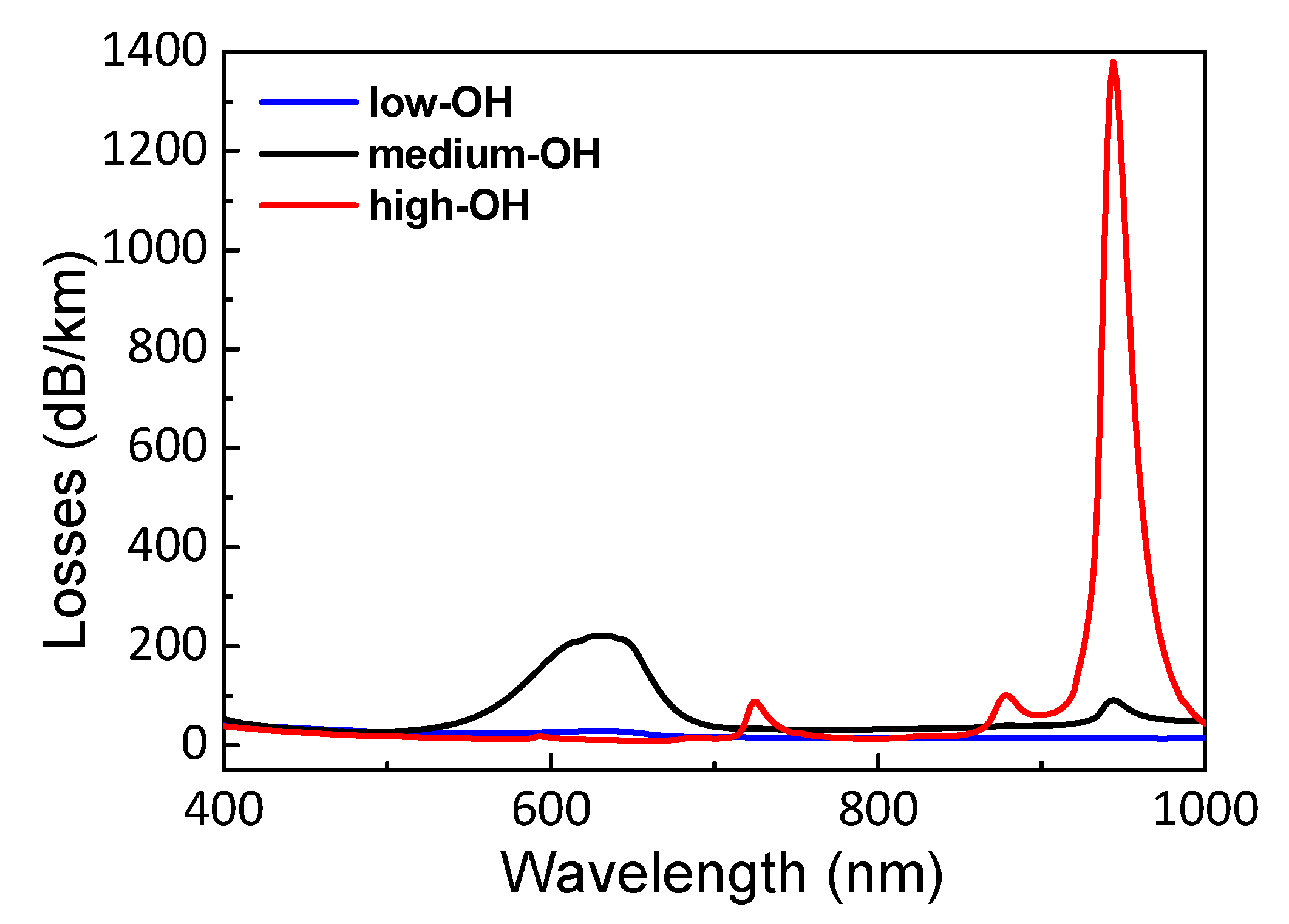
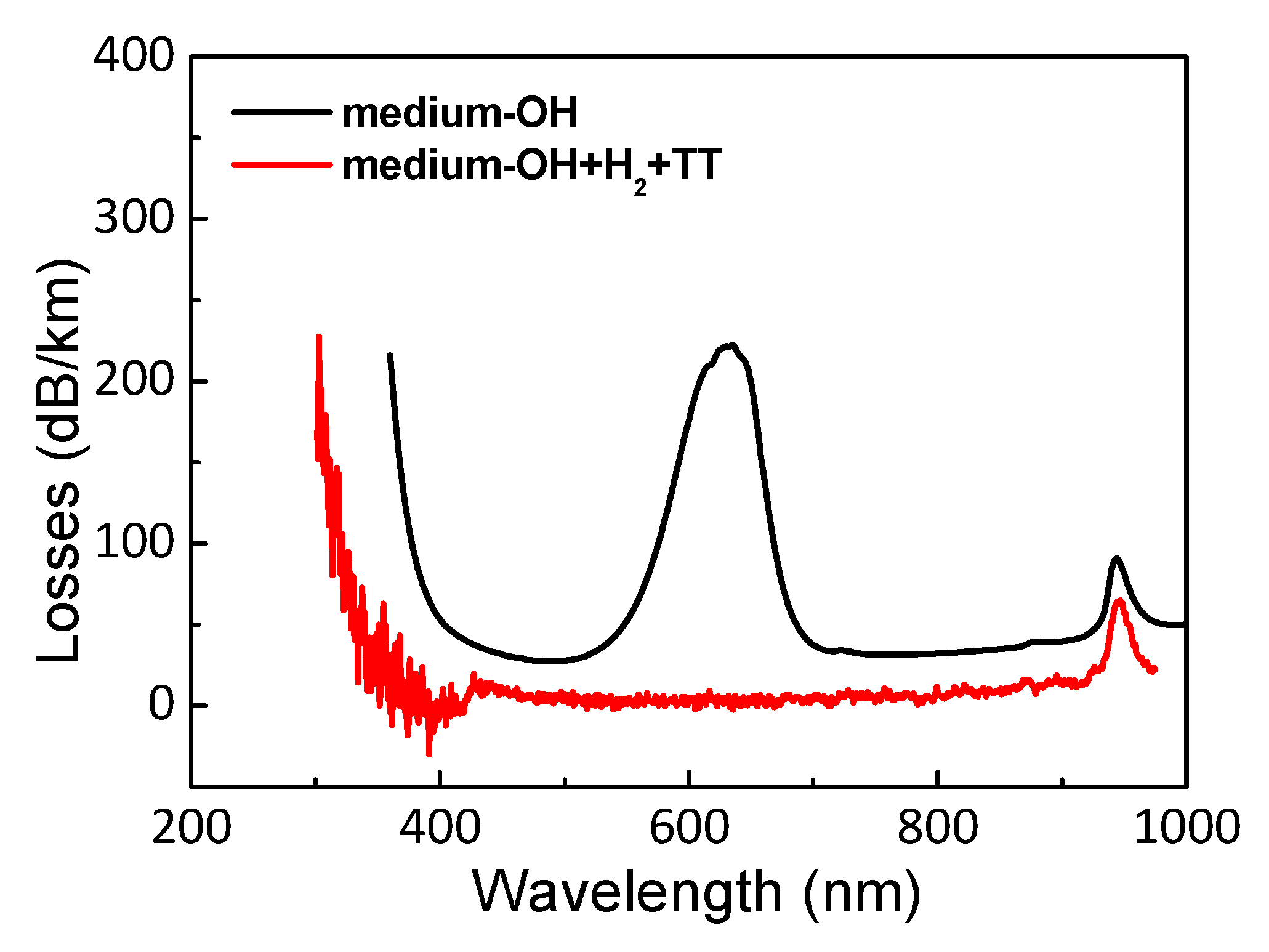
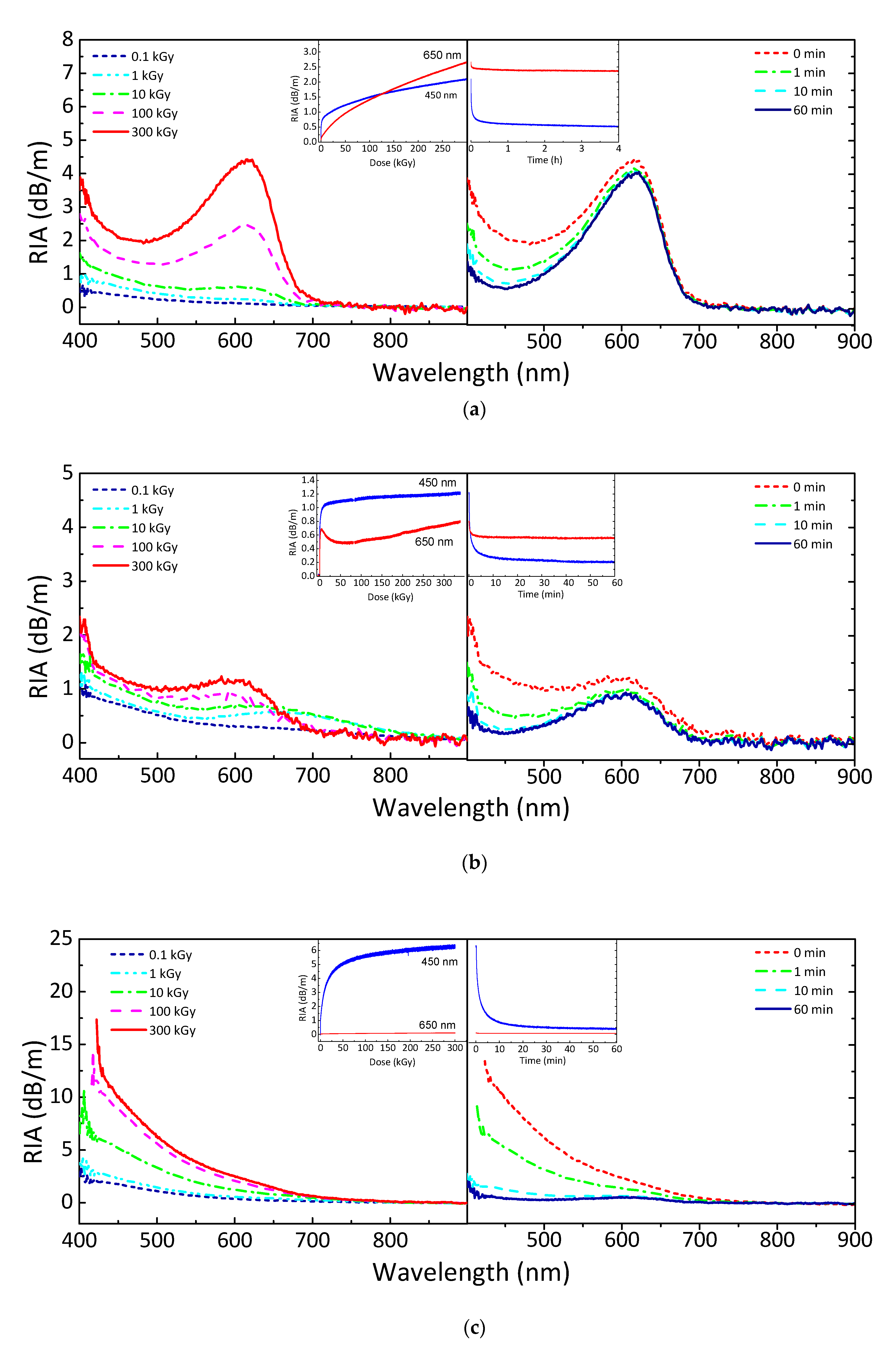



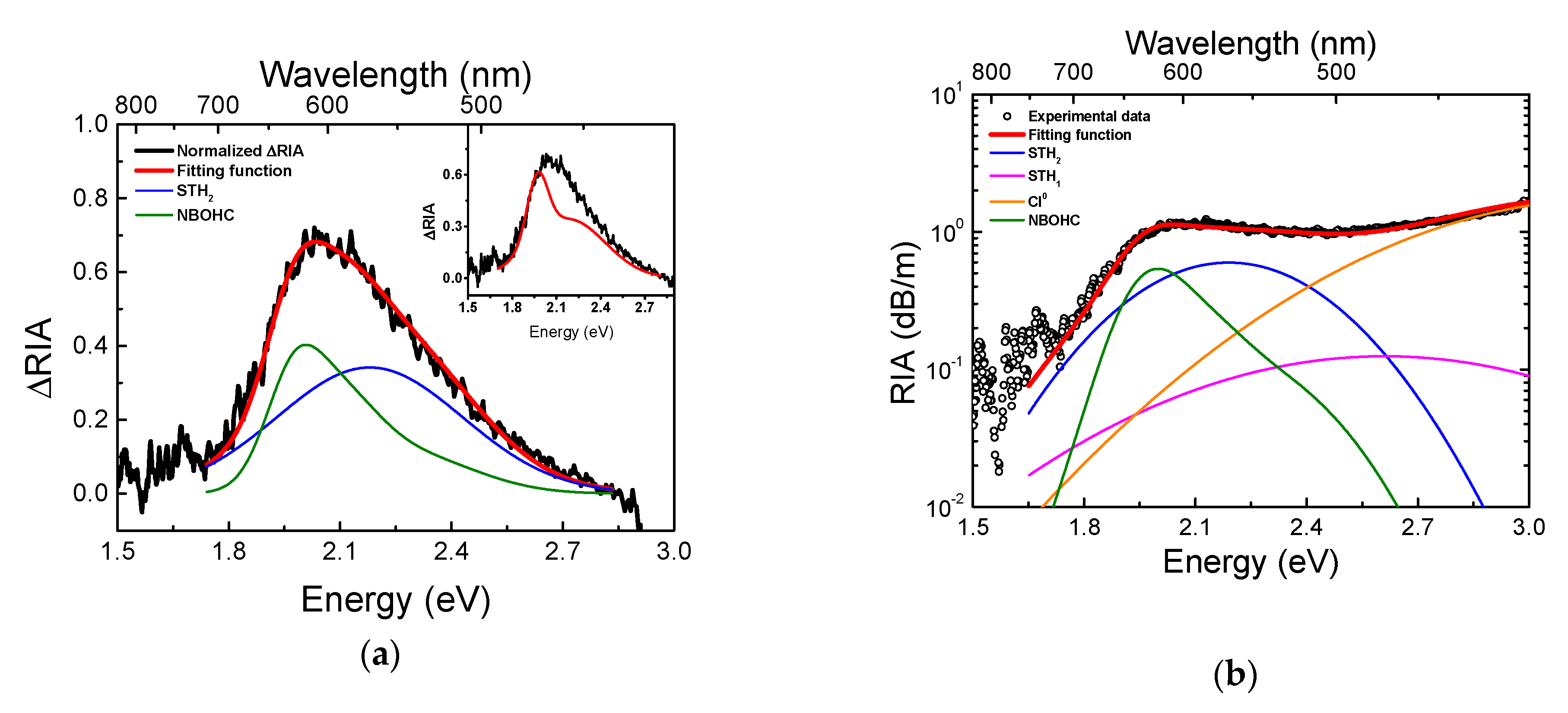

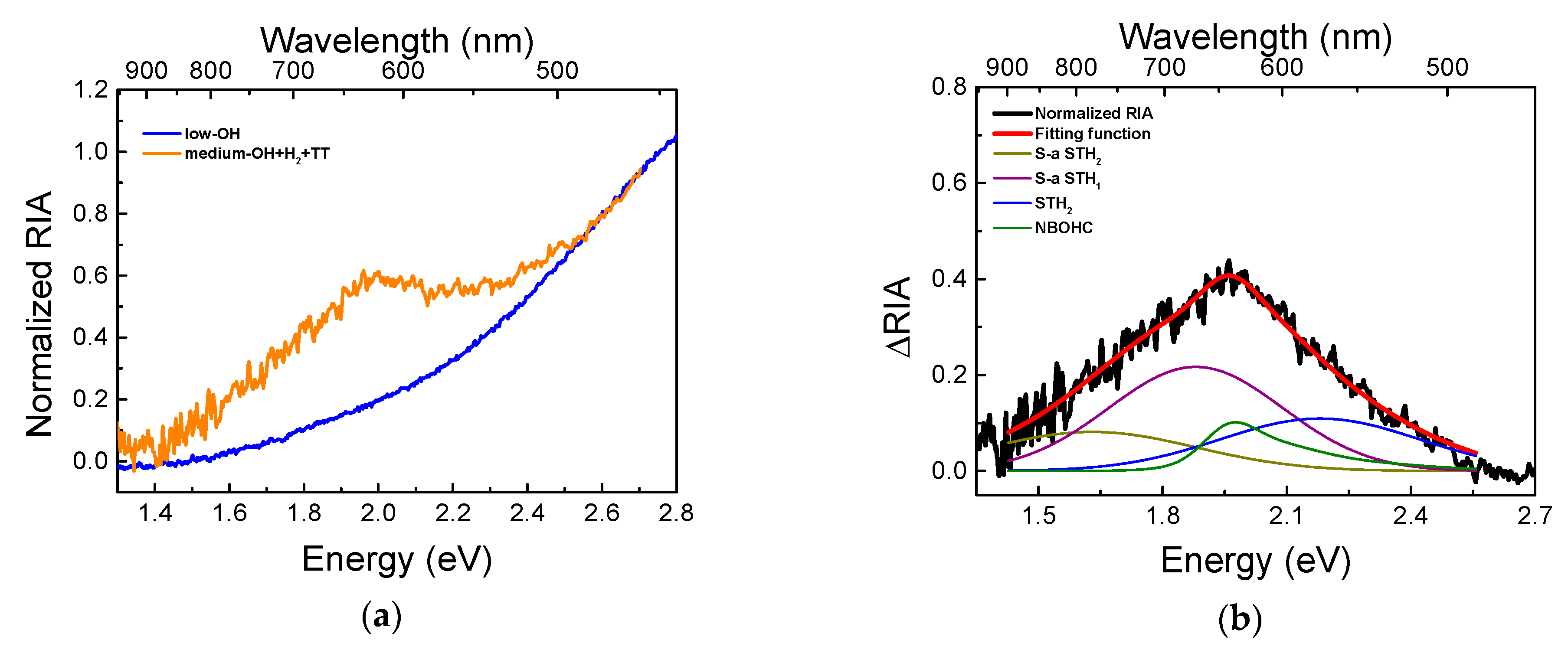
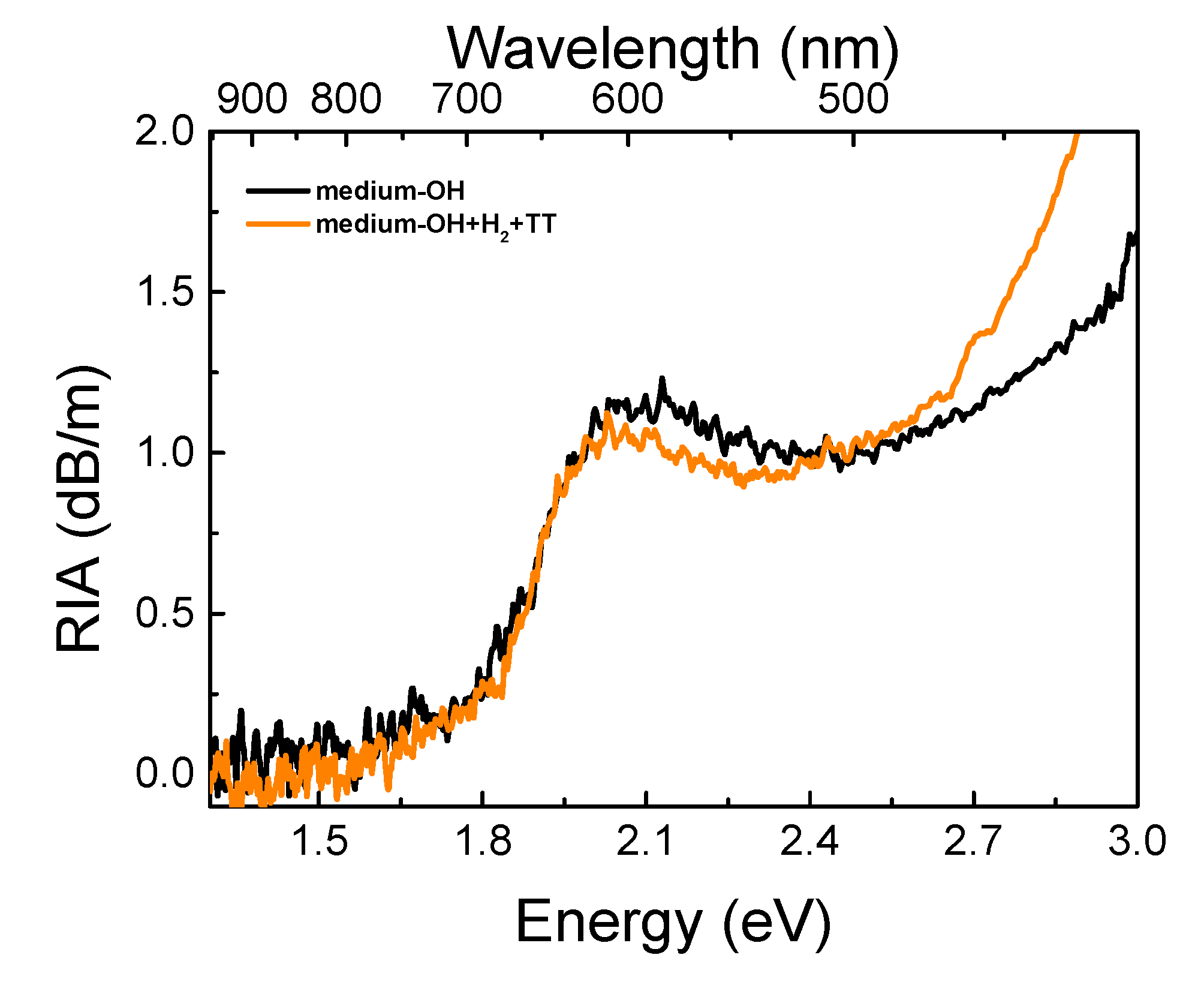
| Sample | Core Diameter [µm] | Cladding/Coating Diameters [µm] | OH Content 1 [ppm] |
|---|---|---|---|
| low-OH | 105 | 125/150 | 0.41 |
| medium-OH | 112 | 27 | |
| high-OH | 105 | 873 |
| Point Defect | Ec [eV] | FWHM [eV] | Low-OH 1 | Medium-OH 1 | High-OH 1 |
|---|---|---|---|---|---|
| STH1 | 2.6 | 1.2 | 1 | 0.15 | 0.2 |
| STH2 | 2.16 | 0.6 | 0.77 | 0.36 | 0.46 |
| NBOHC | 1.95, 2.04, 2.21 | 0.16, 0.27, 0.46 | - | 0.05, 0.08, 0.06 | 0.36, 0.55, 0.42 |
| Cl0 | 3.26 | 1.17 | 19.66 | 2.1 | 4.1 |
| Point Defect | Ec [eV] | FWHM [eV] | Medium-OH 1 | Medium-OH+H2+TT 1 |
|---|---|---|---|---|
| STH1 | 2.6 | 1.2 | 0.24 | 0.24 |
| STH2 | 2.16 | 0.6 | 0.17 | 0.09 |
| s-a STH1 | 1.88 | 0.2 | 0.18 | 0.13 |
| s-a STH2 | 1.63 | 0.3 | 0.07 | 0.06 |
| NBOHC | 1.95, 2.04, 2.21 | 0.16, 0.27, 0.46 | 4 × 10−4, 6 × 10−4, 5 × 10−4 | 9.5 × 10−3, 14.5 × 10−3, 11.2 × 10−3 |
| Cl0 | 3.26 | 1.17 | 1.74 | 1.89 |
Publisher’s Note: MDPI stays neutral with regard to jurisdictional claims in published maps and institutional affiliations. |
© 2021 by the authors. Licensee MDPI, Basel, Switzerland. This article is an open access article distributed under the terms and conditions of the Creative Commons Attribution (CC BY) license (http://creativecommons.org/licenses/by/4.0/).
Share and Cite
Campanella, C.; De Michele, V.; Morana, A.; Mélin, G.; Robin, T.; Marin, E.; Ouerdane, Y.; Boukenter, A.; Girard, S. Radiation Effects on Pure-Silica Multimode Optical Fibers in the Visible and Near-Infrared Domains: Influence of OH Groups. Appl. Sci. 2021, 11, 2991. https://doi.org/10.3390/app11072991
Campanella C, De Michele V, Morana A, Mélin G, Robin T, Marin E, Ouerdane Y, Boukenter A, Girard S. Radiation Effects on Pure-Silica Multimode Optical Fibers in the Visible and Near-Infrared Domains: Influence of OH Groups. Applied Sciences. 2021; 11(7):2991. https://doi.org/10.3390/app11072991
Chicago/Turabian StyleCampanella, Cosimo, Vincenzo De Michele, Adriana Morana, Gilles Mélin, Thierry Robin, Emmanuel Marin, Youcef Ouerdane, Aziz Boukenter, and Sylvain Girard. 2021. "Radiation Effects on Pure-Silica Multimode Optical Fibers in the Visible and Near-Infrared Domains: Influence of OH Groups" Applied Sciences 11, no. 7: 2991. https://doi.org/10.3390/app11072991







